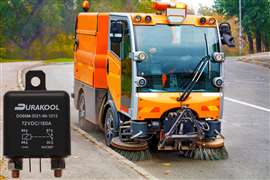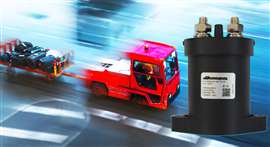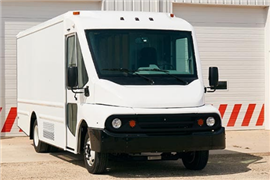Read this article in Français Deutsch Italiano Português Español
Enhancing energy efficiency in contactors and relays for mobile applications
07 May 2025
Contactors and relays are electromagnetic switches essential for managing electrical flow in mobile applications. Their primary function is to control high currents and voltages while ensuring operational safety and efficiency.
For OEMs developing industrial vehicle components, these switches play a critical role in the vehicle’s operation, allowing the connection and disconnection of the battery under both normal and fault conditions.
A key challenge in using contactors and relays, however, is their power consumption. The large coils required to handle these high-current devices can continuously draw energy, draining the battery and reducing the vehicle’s operational range. Addressing this is essential for enhancing performance.
Energy Efficiency Innovations
Fortunately, the industry has developed advanced economizer technologies that significantly reduce the power draw of contactors and relays while maintaining reliability. Some key innovations stand out.
 An electric road sweeper that uses the Durakool DG86M relay. (Photo: Durakool)
An electric road sweeper that uses the Durakool DG86M relay. (Photo: Durakool)
One is pulse width modulation (PWM) technology. By modulating the electrical pulse width, PWM reduces coil power consumption by approximately 50 percent. This allows the contactor to remain engaged while using less energy, extending battery life and improving vehicle efficiency.
Then there is the dual-coil economizer, which employs a high-power coil for initial activation and a low-power coil to sustain operation. Reducing power consumption during prolonged use in this way enhances energy efficiency. Dual-coil designs also offer lower cost and fewer points of failure because of fewer components used on the printed circuit board (PCB).
Of the two, PWM offers better efficiency than the dual-coil design and provides more precise control over energy consumption, even though it uses a more complex electronic circuit. However, the pulsing can generate electromagnetic interference (EMI), which would mean additional shielding to avoid affecting external electronic circuits. The dual-coil economizer, by contrast, does not generate EMI, making them more reliable.
A third approach to coil economizing involves reducing voltage once the contacts are engaged. While effective, this method requires an external circuit. Additionally, there is a risk of under-energizing the coil, which could lead to reliability issues.
In any case, when selecting the appropriate technology for the application, OEMs must carefully weigh these trade-offs.
Sensitive Coil Technology
Another advancement in the field is sensitive coil technology. This approach reduces power consumption by incorporating high-resistance coils that require significantly less current to operate. This makes it particularly well-suited for electric vehicle (EV) applications, where it helps lower operational costs, prolong battery lifespan and reduce the overall environmental impact by minimizing the energy required for switching functions. However, the downside is that the design can lead to slightly less contact pressure, which will reduce carry current capability.
Regardless of which technology OEMs choose, they must take care to ensure a minimum amount of time to fully engage the contacts, typically 100 - 200ms.
Contact Material Advancements
Another crucial factor in improving efficiency is selecting the right material for the contact rivets. The electrical resistance of these materials directly affects energy consumption, heat generation and the component durability.
 The Durakool DLVC300 contactor is used in some airport towing trucks. (Photo: Durakool)
The Durakool DLVC300 contactor is used in some airport towing trucks. (Photo: Durakool)
There are a range of advanced materials that can optimize performance across different applications. Silver nickel (AgNi), for example, offers low resistance and minimizes energy loss in relays that remain closed and carry high current for extended periods. By comparison, silver tin oxide (AgSnO2) provides high resistance to welding when switching under load by reducing heat build-up and energy waste.
Another silver variant is silver tin oxide indium oxide (AgSnOInO), a specialized material also designed to resist welding, making it ideal for frequent switching applications in electric motors. AgSnOInO enhances long-term system reliability in mobile applications by significantly reducing contact degradation.
Two copper options include oxygen-free copper (Cu. C10200) and copper silver alloy (T2+Ag). Cu. C10200 provides lower contact resistance and superior performance when carrying high current for long periods. T2+Ag is a harder material that excels when switching under load conditions, offering different performance characteristics for specific applications.
Adoption Challenges
Before OEMs can adopt and integrate such improvements into their designs, they must address some key challenges.
One hurdle is thermal management. Because high-current applications generate significant heat, there must be effective cooling solutions to maintain performance and prevent premature failure.
Additionally, the rapid growth in EV production has led to supply chain constraints. These can strain component availability from manufacturers, potentially creating bottlenecks in production schedules.
Finally, there is integration complexity due to a lack of standardized relay designs that can leads to compatibility issues. For instance, different manufacturers may have variations in pin configurations, mounting arrangements or terminal assignments. OEMs must consider this complexity during the design phase to ensure smooth integration.
Real-World Applications
 Carlos Mendes is product manager for switching at Durakool, (Photo: Durakool)
Carlos Mendes is product manager for switching at Durakool, (Photo: Durakool)
The impact of these enhanced energy-efficient technologies is most evident in next-generation vehicle components that require efficiency, durability and reliability. For instance, these technologies have already been successfully implemented in electric buses, postal vehicles and tow tractors and construction equipment, such as backhoes and telehandlers.
As the industry advances, we can expect to see other innovations. These include further miniaturization of components without sacrificing high-current capabilities, enhanced thermal management solutions to improve reliability in demanding environments and greater standardization to simplify integration challenges. Additionally, more sustainable materials will reduce environmental impact and allow components to be recycled.
The industry will overcome energy efficiency challenges through continuous innovation and strategic engineering while driving towards a more sustainable, electrified future.
POWER SOURCING GUIDE
The trusted reference and buyer’s guide for 83 years
The original “desktop search engine,” guiding nearly 10,000 users in more than 90 countries it is the primary reference for specifications and details on all the components that go into engine systems.
Visit Now
STAY CONNECTED




Receive the information you need when you need it through our world-leading magazines, newsletters and daily briefings.
CONNECT WITH THE TEAM












